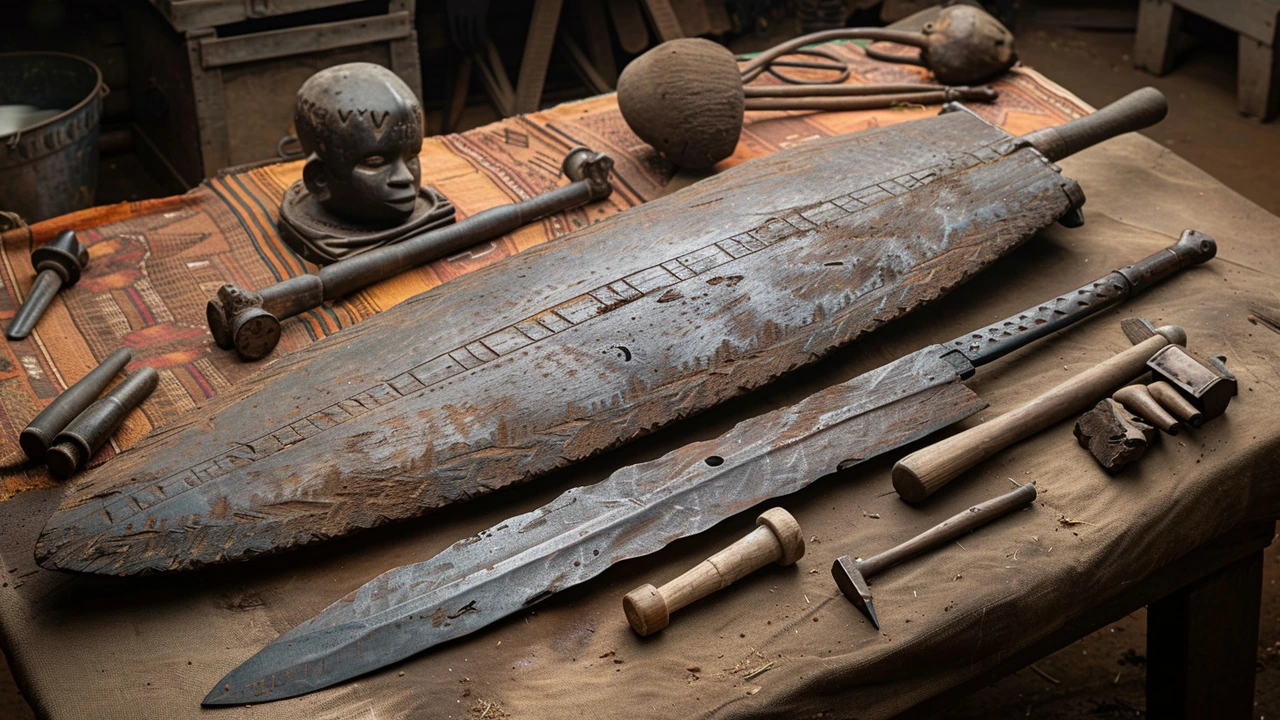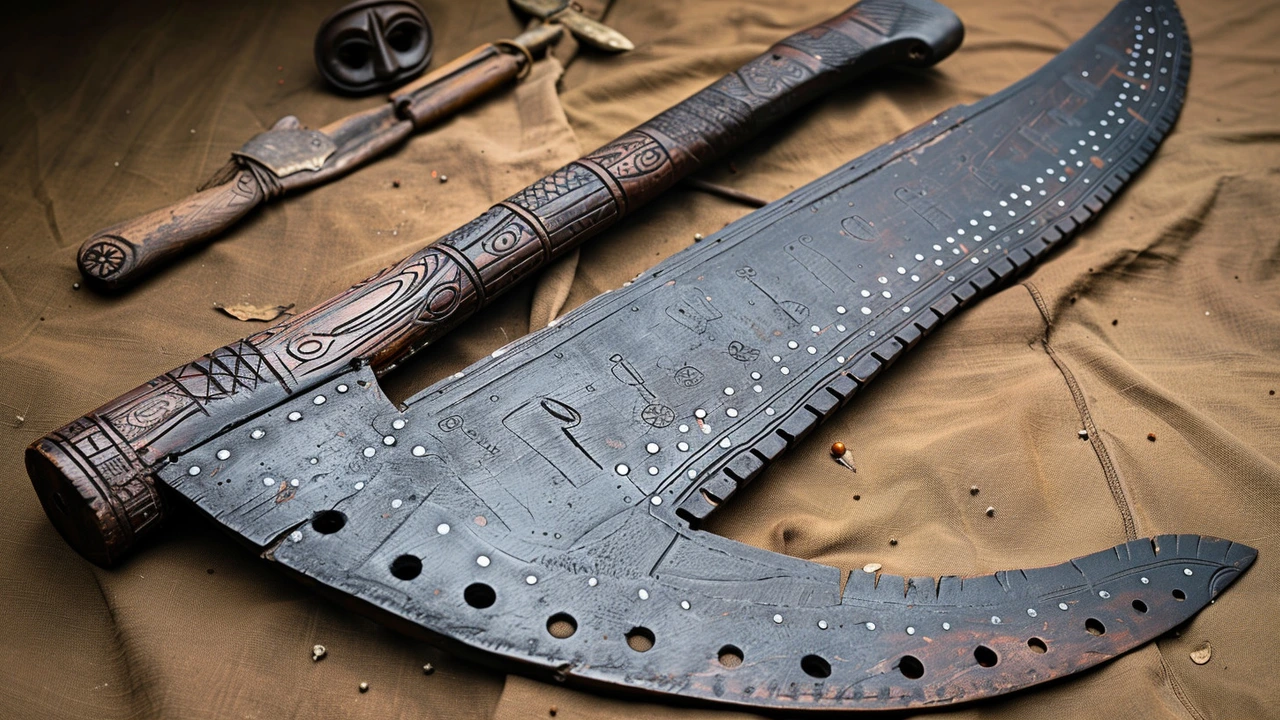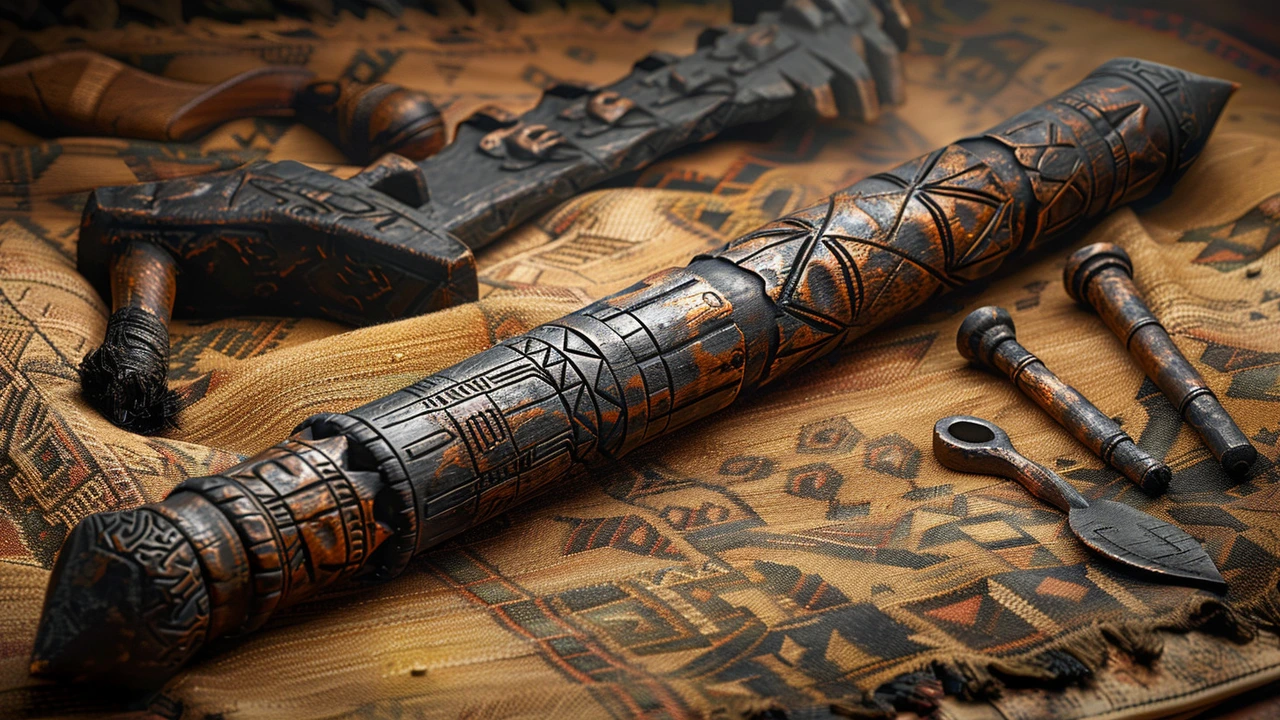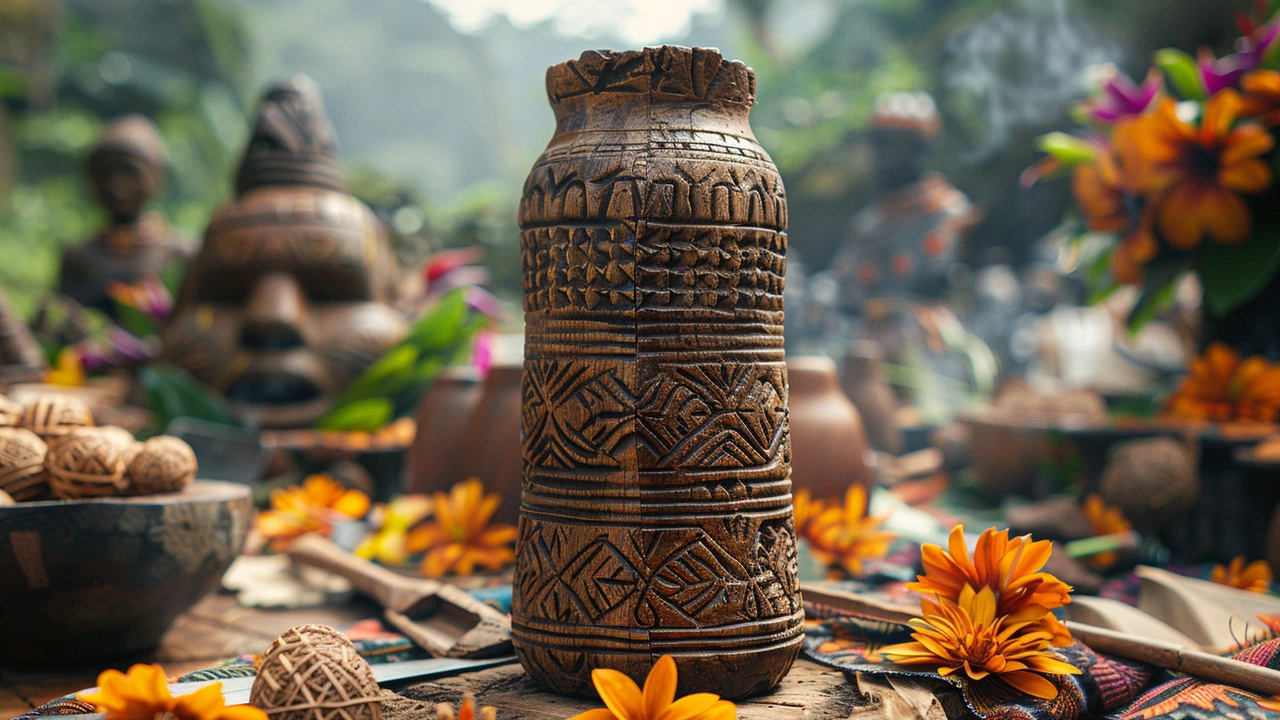Exploring the Intriguing History and Use of the Rungu
 Jun, 27 2024
Jun, 27 2024
The Rungu, a traditional African weapon and emblem of strength, has a rich history and cultural significance. Originating from the Maasai and other East African communities, this club-like tool is crafted with care and precision, echoing stories of valor and heritage.
The Rungu is not just about its physical appearance but the profound symbolism it holds. It serves as a rite of passage and a mark of status in many cultures. Understanding its origins can deepen our appreciation of its role in African societies.
The creation of a Rungu involves skilled craftsmanship, usually from indigenous hardwoods. Each Rungu tells a unique story, reflective of the artisan's techniques and cultural motifs.
Today, the Rungu remains relevant, cherished in both traditional ceremonies and contemporary uses. Preservation efforts are vital for maintaining this cultural treasure, allowing us to keep alive the rich heritage it represents.
- The Origins and History of the Rungu
- Cultural Significance and Symbolism
- Craftsmanship and Construction
- Modern Uses and Preservation
The Origins and History of the Rungu
Originating from East African tribes, particularly the Maasai, the Rungu is a short, club-like weapon traditionally used in combat and hunting. The origin of its use dates back centuries, intertwined with the daily life and rituals of East African communities. The Maasai warriors, known as Moran, were famed for their bravery, and the Rungu was an essential part of their arsenal. Its creation and use were deeply embedded in the societal structure, serving not just as a weapon but as a symbol of power and authority.
Interestingly, the Rungu has a dual role. While it was a weapon during conflicts and hunts, it was also a ceremonial object. In various initiation ceremonies, young Maasai men received a Rungu as a rite of passage. This act marked their transition from boyhood to warrior status, acknowledging their readiness to protect their community. A historical recounting of the Rungu also shows its presence in the administrative hierarchy. Tribal leaders and elders often carried elaborately decorated versions of these clubs, signifying their status and authority.
Throughout the 19th and early 20th centuries, European explorers and colonialists documented their encounters with the Maasai and the Rungu. Notable accounts, such as those by Joseph Thomson, highlighted the weapon's importance in Maasai culture. In his 1885 book, Thomson wrote,
"The Maasai and their wooden clubs, known as Rungus, struck a remarkable image of both elegance in battle and significance in the social structure."These records provide insights into how the Rungu was perceived by outsiders and how it reinforced the cultural fabric of East African societies.
The evolution of the Rungu's design also reflects various influences and technological advancements over time. While traditionally carved from local hardwoods, such as Acacia or Olive trees, newer variations incorporated sturdier materials for improved durability and efficacy. The skill required to create a Rungu was passed down through generations, making it a profound expression of heritage and craftsmanship.
Migration patterns within and beyond Africa also played a role in spreading the knowledge and use of the Rungu. As traditions intermingled, the Rungu found new purposes and variations across different landscapes and cultural contexts. However, despite these changes, its essence as an emblem of strength and honor remained untouched.
By understanding the Rungu's origins and historical context, we gain a deeper appreciation of its multifaceted role in African culture. It's not just a tool but a vessel carrying the stories, values, and traditions of its people. The history of the Rungu serves as a testament to the ingenuity and resilience of the communities that crafted and wielded it, making it much more than a simple club.

Cultural Significance and Symbolism
The Rungu carries profound cultural significance and deep symbolism within African societies, particularly among the Maasai and Samburu people of East Africa. This traditional weapon, often handed down through generations, is much more than a tool for defense. It is a symbol of authority, bravery, and manhood. Amongst the Maasai, receiving a Rungu is an important rite of passage that signifies a young warrior’s transition into adulthood.
The Rungu is typically presented in ceremonies that mark critical life events, such as transitioning from boyhood to warrior, or from warrior to elder. As such, it is imbued with a sense of accomplishment and respect. When a Maasai warrior, or moran, carries a Rungu, it denotes his readiness to protect his community and livestock, a role of incredible importance in traditional Maasai society. In many cases, the Rungu is used in ceremonial dances and rituals, reinforcing its role in cultural traditions.
A noteworthy aspect of the Rungu is its role in storytelling. Elders often use the Rungu as a pointer while recounting tales of heroism and adventure. It serves as a visual aid that keeps listeners engaged and adds a vividness to the storytelling experience. The presence of the Rungu in these narratives further solidifies its place in the cultural milieu. As the legendary Maasai adage goes, 'A warrior without a Rungu is like a warrior without courage.'
The symbolic value of the Rungu extends to the understanding of social hierarchies within these communities. Chiefs and leaders often carry elaborately carved or decorated versions, differentiating their status and roles. In some regions, the patterns carved into the Rungu have meanings that communicate specific messages about the owner's lineage, achievements, or characteristics. These intricate designs make each Rungu a unique artifact with a story etched into its surface.
"The Rungu is not merely a weapon; it is the embodiment of our history and pride," says Chief Kitoi, a respected leader among the Maasai. "It connects us to our ancestors and reminds us of our duties as protectors of our community."
The symbolic importance of the Rungu also finds reflection in contemporary art and design. Artists and artisans frequently incorporate elements of the Rungu into their work, using it as an inspiration for jewelry, clothing, and home decor. This not only showcases the Rungu's enduring relevance but also helps in educating a broader audience about its cultural significance.
In the modern age, preserving the cultural significance of the Rungu is crucial. There are ongoing initiatives to document and celebrate this iconic artifact through museums, cultural exhibitions, and educational programs. These efforts aim to ensure that future generations can appreciate and continue the traditions associated with the Rungu. By understanding and honoring the Rungu's rich cultural symbolism, we contribute to the preservation of a vital part of African heritage.

Craftsmanship and Construction
The construction of a Rungu is a delicate process. It starts with selecting the right type of wood. Indigenous hardwoods such as African blackwood, acacia, or olive wood are preferred due to their durability and heft. The choice of wood is crucial, as it affects both the resilience of the weapon and its symbolic value.
The crafting begins with the artisan cutting a suitable branch, generally from a tree with cultural significance. The wood is then left to dry, a process that can take several weeks. This drying stage is vital as it ensures stability and minimizes future cracking. Once dried, the piece is roughly shaped using hand tools such as machetes or knives. The artisan carves the distinctive bulbous head, traditionally round or slightly oblong, and the wooden shaft carefully to maintain natural lines of the wood.
Attention to detail marks every stage of Rungu creation. The head of the club can be left smooth or decorated with intricate carvings. Skilled artisans often imbue the Rungu with cultural motifs, symbols that might represent bravery, strength, or religious beliefs. These carvings are more than mere decoration—they are a narrative of the community's values and history.
The late Maasai elder Ole Kentapash once remarked, "A Rungu is more than a weapon; it's our heritage carved in wood, passed from father to son."
Finishing the Rungu involves sanding the entire piece to a fine smoothness. This process can take hours as the artisan ensures there are no splinters or rough edges. A high-quality Rungu might then be oiled or polished to enhance its appearance and preserve the wood. The final product is not only appealing but functional, embodying a balance of aesthetic beauty and practical efficiency.
The time and labor invested in each Rungu often lead to unique variations even within the same region. Thus, a Rungu serves as a testimony to the artisan’s skill and the cultural heritage of the community it originates from. While the basic form remains consistent, personal and regional differences add to its charm and distinctiveness.
Modern versions of the Rungu might incorporate more contemporary materials or designs, especially for decorative purposes. However, traditional craftsmanship is still highly valued. Preserving these techniques ensures that the cultural narratives and artisanal skills are passed down through generations. The creation of a Rungu, then, is not just a manual task but a deeply symbolic act that connects past, present, and future.

Modern Uses and Preservation
The **Rungu** has transcended its traditional roots, finding a place in modern society while retaining its cultural integrity. Today, the Rungu is appreciated both as a practical tool and an artistic symbol. In regions where traditional practices are still prevalent, the Rungu continues to be used in ceremonies and rituals. Its role in rites of passage, such as coming-of-age ceremonies, remains significant.
The Rungu's practical uses are not confined to symbolism alone. Farmers and herders utilize it for everyday tasks, such as herding cattle or as a defense tool against wild animals. Its effectiveness in these roles speaks to its robust design and practical origins. In urban areas, the Rungu is often displayed as a piece of cultural art. Intricately designed versions are sold as souvenirs, allowing travelers and collectors to own a piece of African heritage.
Preservation of the Rungu and its cultural meanings is crucial. Efforts are being made by several organizations to ensure that this traditional weapon is not lost to time. Preservation initiatives often involve collaboration with local artisans who pass down their skills to younger generations. In many communities, workshops and schools teach the traditional methods of crafting Runqus, ensuring that the knowledge and skills remain alive.
Tourism also plays a role in the Rungu's modern significance. Visits to Maasai villages and cultural centers offer a glimpse into the traditional ways of life, including demonstrations of Rungu crafting and usage. This not only educates visitors but also provides economic support to the artisans and communities that keep these traditions alive.
“The Rungu is more than just a weapon; it is a connection to our ancestors and their wisdom,” says cultural historian Samuel Olelo. “Preserving it means preserving a way of life, a history rich with lessons on resilience and identity.”
In addition to tourism and educational efforts, there are exhibitions and museums that feature the Rungu prominently. The National Museum of Kenya, for instance, has displays dedicated to the tools and weapons of various ethnic groups, including the Rungu. Such exhibitions highlight the craftsmanship and diverse uses of this unique item, bringing its story to a broader audience.
Digital preservation methods are increasingly being utilized as well. Online databases and virtual museums allow people worldwide to explore the Rungu's history and significance. These digital archives often include detailed photographs, descriptions, and even virtual tours. Such efforts make the Rungu accessible to anyone with an internet connection, ensuring its heritage is shared globally.
The **modern uses** of Rungus are varied and rich, demonstrating the adaptability and enduring importance of this cultural artifact. The preservation efforts ensure that future generations will continue to understand and appreciate the Rungu's historical and cultural value. In this way, the Rungu remains not just a relic of the past but a thriving symbol of cultural identity and continuity.
